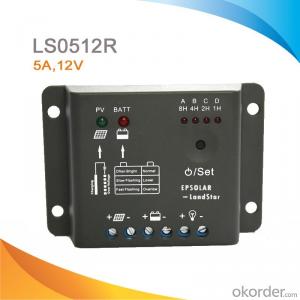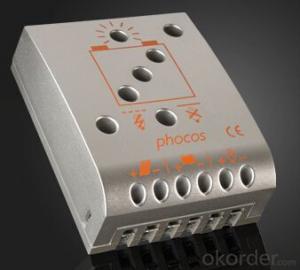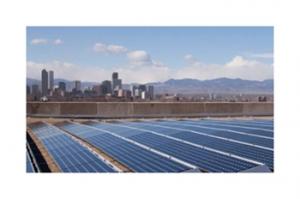Multiple Solar Charge Controllers - Solar CXN Series (10 – 40 A) Programmable Solar Charge Controller with Negative Grounding
- Loading Port:
- China Main Port
- Payment Terms:
- TT or LC
- Min Order Qty:
- -
- Supply Capability:
- 10000 unit/month
OKorder Service Pledge
OKorder Financial Service
You Might Also Like
1, Product desciption
The DC power for the inverter section can be derived from a normal AC wall outlet or some other source. Control and feedback circuitry is used to adjust the final output of the inverter section which will ultimately determine the speed of the motor operating under its mechanical load.
Motor speed control needs are numerous and include things like: industrial motor driven equipment, electric vehicles, rail transport systems, and power tools. (See related: variable-frequency drive ) Switching states are developed for positive, negative and zero voltages as per the patterns given in the switching Table.
The generated gate pulses are given to each switch in accordance with the developed pattern and thus the output is obtained.
2, Features of the product
Inverters convert low frequency main AC power to higher frequency for use in induction heating.
To do this, AC power is first rectified to provide DC power. The inverter then changes the DC power to high frequency AC power. Due to the reduction in the number of DC Sources employed, the structure becomes more reliable and the output voltage has higher resolution due to an increase in the number of steps so that the reference sinusoidal voltage can be better achieved.
This configuration has recently become very popular in AC power supply and adjustable speed drive applications. This new inverter can avoid extra clamping diodes or voltage balancing capacitors. There are three kinds of level shifted modulation techniques, namely
Is the electrical grid already nearby or would you need to call in the power company to bring in electrical lines.
If the electric needs to be brought to the area, how much is this going to cost? Depending on how far the grid electric is from the location of the needed lighting, this can be quite expensive.
How much lighting is needed on the street? Do the lights need to be dark sky compliant.
Do the street lights need to run from dusk to dawn or for only a specified number of hours at night.
Are the street lights able to dim in the middle of the night and still provide enough lighting.
These questions need to be answered before you can decide on how many lights you will need to complete the project.
3, Product Image

4, Detailed Specification
INPUT | |
Input voltage range | 185~265±5Vac |
OUTPUT | |
Output voltage range | 185~265±5Vac (AC mode) , 230Vac (DC mode) |
Output frequency (DC mode) | 50Hz (48~54Hz) or 60Hz(58~64Hz), same as AC(AC mode) 50Hz ±0.3Hz (DC mode) |
Wave form | Sine wave (DC Mode) |
Transfer time | 10ms. (Typical) |
BATTERY | |
Rated charging current (max.) | 45A |
Norminal DC input voltage | 12V |
Min. DC start voltage | 20V / 40V |
PHYSICAL | |
Unit dimension (mm) | 526*277*212 |
Master box dimension (mm) | 620*350*370 |
Net weight (1pc, kg) | 22.8 |
- Q: Can a solar controller be used with a solar-powered mining operation?
- Yes, a solar controller can be used with a solar-powered mining operation. A solar controller is an essential component in managing and regulating the flow of power from the solar panels to the mining equipment. It helps optimize the charging and discharging of batteries, protects against overcharging and over-discharging, and ensures the overall efficiency and performance of the solar power system. Therefore, a solar controller is highly recommended and compatible with a solar-powered mining operation.
- Q: Can a solar controller be used with a solar-powered spa or wellness center?
- Yes, a solar controller can be used with a solar-powered spa or wellness center. A solar controller helps regulate and optimize the charging and discharging of batteries in a solar system, ensuring the efficient use of solar energy. It can be used to monitor and control the solar panels, battery banks, and other components of a solar-powered system in a spa or wellness center, providing reliable and sustainable power for various equipment and facilities.
- Q: Can a solar controller be used in a solar-powered cruise ship?
- Yes, a solar controller can be used in a solar-powered cruise ship. A solar controller is an essential component in solar power systems as it regulates the charging and discharging of batteries, ensuring the efficient and safe operation of the system. In a solar-powered cruise ship, the solar controller would be used to manage the energy flow from the solar panels to the batteries, ensuring optimal power generation and storage.
- Q: How does a solar controller handle battery overvoltage disconnect recovery?
- The battery overvoltage disconnect recovery is managed by a solar controller, which utilizes specific functions and features. When the battery voltage surpasses a particular threshold, the overvoltage disconnect feature of the controller is activated. This feature separates the charging source (solar panel) from the battery to prevent further charging. Once the overvoltage disconnect is triggered, the solar controller enters a recovery mode. Throughout this period, the controller continuously monitors the battery voltage to guarantee that it decreases below a safe level before reconnecting the charging source. This is crucial for safeguarding the battery against potential damage caused by excessive voltage. The recovery process typically includes gradually reconnecting the charging source to the battery. The controller may employ a mechanism that delays reconnection, allowing the battery voltage to stabilize and decrease to a safe level before resuming the charging process. This helps prevent any sudden increases in voltage that could harm the battery. Furthermore, some solar controllers may incorporate a soft-start feature during the recovery phase. This means that instead of immediately supplying the battery with the full charging current, the controller begins with a lower current and gradually increases it until it reaches the desired charging rate. This gentle approach prevents any sudden shocks to the battery resulting from a sudden surge in charging current. In conclusion, the battery overvoltage disconnect recovery mechanism of a solar controller ensures the safe and efficient charging of the battery by carefully monitoring its voltage and implementing gradual reconnection strategies to prevent any further instances of overvoltage.
- Q: What is the maximum input voltage for a solar controller with an LCD display?
- The maximum input voltage for a solar controller with an LCD display depends on the specific model and manufacturer. It is important to refer to the product's specifications or user manual to determine the exact maximum input voltage for that particular solar controller.
- Q: Choose a solar controller which need to have a few conditions
- The controller should have battery overvoltage protection, battery undervoltage protection, load short circuit protection, temperature compensation and other functions, select the controller to choose the quality of the guarantee. Big manufacturers big brand
- Q: How do you prevent voltage spikes with a solar controller?
- One way to prevent voltage spikes with a solar controller is by using a transient voltage suppressor (TVS) diode. This diode is connected across the solar panel's terminals and acts as a safeguard against sudden voltage surges. When a spike occurs, the TVS diode quickly clamps the excess voltage, diverting it away from the solar controller and protecting it from potential damage.
- Q: Can a solar controller be used with a solar-powered outdoor entertainment system?
- Yes, a solar controller can be used with a solar-powered outdoor entertainment system. A solar controller helps regulate the charging and discharging of the batteries connected to the solar panels, ensuring efficient and optimal power management. This is essential for maintaining a stable power supply to the outdoor entertainment system, allowing it to operate effectively even in varying sunlight conditions.
- Q: Can a solar controller be used with a solar-powered outdoor surveillance system?
- Yes, a solar controller can be used with a solar-powered outdoor surveillance system. A solar controller helps regulate the charging and discharging of batteries in a solar-powered system, ensuring optimal performance and battery lifespan. It is essential for managing the power generated by the solar panels and efficiently supplying it to the surveillance system, making it a valuable component for such setups.
- Q: Can a solar controller be used with both 12V and 24V batteries?
- Yes, a solar controller can be used with both 12V and 24V batteries. Most solar controllers are designed to be compatible with multiple battery voltages and can automatically adjust their charging parameters accordingly. However, it is important to ensure that the solar controller is capable of handling the specific voltage requirements of the batteries being used.
Send your message to us
Multiple Solar Charge Controllers - Solar CXN Series (10 – 40 A) Programmable Solar Charge Controller with Negative Grounding
- Loading Port:
- China Main Port
- Payment Terms:
- TT or LC
- Min Order Qty:
- -
- Supply Capability:
- 10000 unit/month
OKorder Service Pledge
OKorder Financial Service
Similar products
Hot products
Hot Searches
Related keywords




























